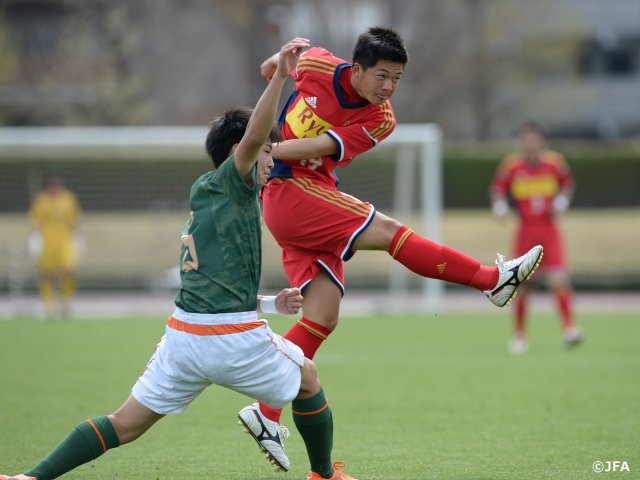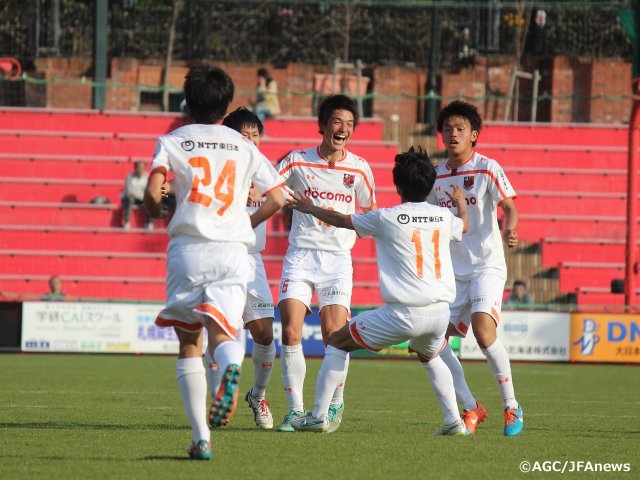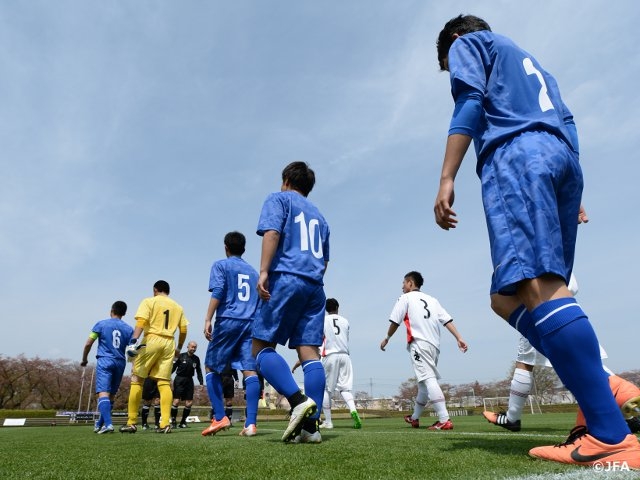NEWS
Review - MD 1 to 6 of Prince Takamado Trophy U-18 Football League 2015 Premier League EAST by Kanto Youth Sub Director KAGEYAMA Masanaga
08 June 2015

After beginning its season on 12 April, the Prince Takamado Trophy U-18 Football League 2015 Premier League EAST entered a one-month-and-half break on 10 May and will resume its season on 27 June. Kanto Youth Sub Director KAGEYAMA Masanaga, a member of the 2015 Premier League Technical Study Group, looks back the six Premier League EAST matchdays, one-third of the whole season.
Looking at Early Stage via Stats — Goals
The total goals scored in the 30 matches in the six matchdays are 75, which means the average goals per match are 2.5. This number is similar to the 1998 FIFA World Cup France and is almost as many as the all-time record of 2.67 goals scored at the 2014 FIFA World Cup Brazil. This reflects aggressive attacking efforts in the league.
Above all, what is remarkable is that there were only two scoreless matches. As the number of matches sharing spoils is only seven, the fact that many matches ended with a winner clearly determined record-wise is also one of the features of the league.
But it could be conversely said that there were a lot of carelessness in matches. There were eight matches where one team scored three or more goals and five matches where one scored four or more.
I'm not sure whether losing teams lost confidence and concentration as they conceded goals or teams scoring goals caught their momentum and got in the so-called “zone”. But in any case, it is also true that a number of matches were off the track of our purpose which was raising the level by letting them experience the closely-fought league campaign.
Compared with the figure of the last year, the total score of 88 goals (average of 3.52 per game, it took break after MD 5 last year) of this year is almost equivalent to the last year, considering there were 12 games of more than three goals.
The team who scored most in a single match was F.C. Tokyo U-18 with 6 goals (6-0 over JFA Fukushima and 6-1 over Consadole Sapporo). F.C. Tokyo U-18 have scored league high 18 goals so far. On the other hand, leaders Kashima Antlers Youth conceded league-lowest two goals. Their goal against average of 0.33 proves outstanding defensive stability.
It is interesting to see how the league evolves from this point. It can become more aggressive or teams can be more careful as the season end gets closer and each one of the matches becomes more important. And it is also must-see how teams who show their trait in offence or in defence change over time.

How One-third Works for Rest of Two-thirds
After six matches, the league leaders are Kashima Antlers Youth with 16 points. Ichiritsu Funabashi High School trail the leaders with 14 points, followed by F.C. Tokyo U-18 with 11 points and Omiya Ardija Youth with 10 points. Instead, JFA Academy Fukushima and Consadole Sapporo have struggled with no point and 3 points respectively. It is no question that Kashima, Ichiritsu Funabashi, and Omiya got off to a perfect start with the unbeaten run.
Here I look at how much the first six matches affect the final result in the long-run league campaign by comparing to the past four seasons (five matches in 2014).
– Champions: In the past four years, all teams who eventually became champions stood at least in second place at the season break. All second-placed teams stood in third place or higher, except for Shimizu S-Pulse Youth coming back up from ninth place in 2013.
In the face of this data, it is said that the result of the early stage, even though it is just one-third of the whole season, is of considerable importance that can have a major effect for them to finish in the top places.
- Relegated Teams: While there were three cases where bottom teams after six matches were relegated at the season end, there is also an example of JFA Academy Fukushima finishing at fifth place in the end despite ending the early stage at the bottom. Tokyo Verdy Youth, who were at fourth place after the first six matches, and Mitsubishi Yowa Youth, who were at sixth, had a bitter experience, falling down to ninth place and to the bottom respectively.
Looking at the past four year's data, the relegation battle has apparently more uncertainties than the title race.
Attracting Part of League Competitions
The long-run league has lots of plus sides for teams, players and coaches. For example, no matter whether you win or lose the previous one, you can make a preparation and challenge in the next one by changing your players and tactics for improvement. Home-and-away battles and points and goal difference widen a range of choices in your strategy and tactics.
However, a victory and a loss go both positive and negative. A victory does not always work in a positive way, and it sometimes brings you overconfidence that causes your lack of concentration. A loss is not always negative and sometimes it boosts a good preparation with a sense of urgency and leads to high level of performance.
How those events and results that happen every time every week will affect each other in the two-thirds of the season is something you can keep your eye on. Enjoy the attracting part of league competitions through the Prince Takamado Trophy U-18 Football League 2015 Premier League.

Related News
-
Competitions
2015/05/11
Ichiritsu Funabashi High post come-from-behind win vs archrivals in Prince Takamado U-18 Premier League EAST

-
Competitions
2015/05/07
Unbeaten Kashima retain top spot – Prince Takamado Trophy U-18 Premier League EAST

-
Competitions
2015/05/03
Ichiritsu Funabashi win two consecutive clean-sheet matches for the third time in Prince Takamado Trophy U-18 Premier League EAST

-
Competitions
2015/04/27
Omiya post first win of season in Prince Takamado Trophy U-18 Premier League EAST

-
Competitions
2015/04/20
F.C. Tokyo U-18 beat RKU Kashiwa High in four-goal shutout - Prince Takamado Trophy U-18 Premier League EAST

-
Competitions
2015/04/13
Kashiwa, Omiya share spoils - Prince Takamado Trophy U-18 Premier League EAST

Latest News
-
National Teams
2024/05/02
U-15 Japan National Team squad & schedule - Croatia Tour (5/11-5/21@Croatia)

-
National Teams
2024/04/30
【Match Report】U-23 Japan National Team book their ticket to the Paris Olympics with victory over Iraq in the AFC U23 Asian Cup Qatar 2024™ semi-final

-
National Teams
2024/04/26
【Match Report】U-23 Japan National Team defeat host nation to reach semi-finals of the AFC U23 Asian Cup Qatar 2024™

-
National Teams
2024/04/23
【Match Report】U-23 Japan National Team lose to Korea Republic to advance to knockout stage as runners-up - AFC U23 Asian Cup Qatar 2024™

-
National Teams
2024/04/20
【Match Report】U-23 Japan National Team advance past group stage with two consecutive clean sheets - AFC U23 Asian Cup Qatar 2024™


